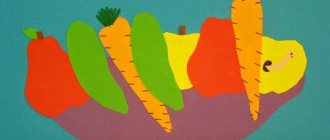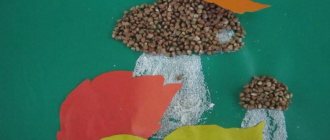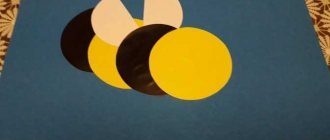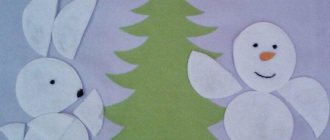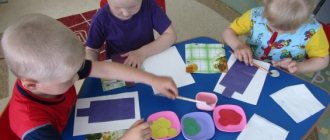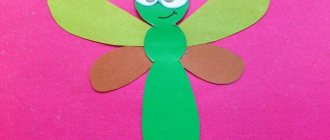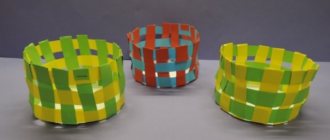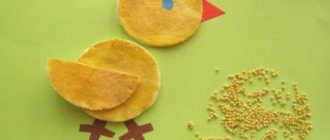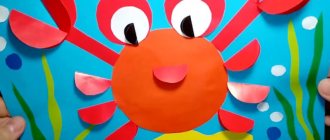Paper bunny
You can make such a bunny just like that, or you can time the craft for Easter. With the help of parents, the child will be able to make the craft quickly and easily, and a minimum of materials will be required:
- Cardboard for the base and white paper;
- Glue;
- Scissors;
- Felt pen;
- A small piece of pink paper;
- A stapler or thread with a needle to secure the accordion.
Operating instructions:
- Cut a sheet of white A4 paper in half crosswise;
- Place the short side of the sheet in front of you and begin folding it into an accordion. Each fold should not be very wide, about 1 centimeter, or narrower. It is important that the folds are even;
- The same must be repeated with the second half of the sheet;
- Next, the two accordions are glued together and bent in the center. To ensure that the bend point is fixed, you can fasten it with staples or tie it with threads;
- Now you need to get a circle from this accordion. The top and bottom parts are glued together. It turns out the face of a bunny;
- The muzzle needs to be glued onto the base, and then continue to design the craft, cutting out and gluing the remaining parts;
- According to the instructions for children in this craft, ears are then cut out from white paper, inserts into the ears are made of pink paper, and glued to the muzzle on the base;
- Next, a muzzle is cut out of pink paper, a nose and points for a mustache are drawn on it;
- You need to cut out eyes from white paper and draw pupils in them;
- The final stage is the final assembly of all the parts and gluing them to the muzzle.
Application “Domestic and wild animals”
Pupils were introduced to the topic “Domestic and wild animals” during classes on the surrounding world in the junior and middle groups. They know the classification of animals, to what extent certain ones depend on environmental conditions, and how they adapt to existence. They know the habitats of wild animals, some behavioral features, which animals are herbivores and which are predators. They can tell no less about domestic animals: those who live on a farm, and about pets in city apartments. Repetition and consolidation are most successful when calendar and thematic planning for the year is compiled in such a way that a return to the topic of animals occurs first in a lesson on cognitive and speech development. Pupils, together with the teacher, systematize previously acquired knowledge, develop oral speech skills, and develop an attitude towards an attentive attitude towards the surrounding world, including animals, towards a healthy lifestyle with the maximum harmony with nature in the modern world. And later, in planning, a creative activity is organized on the same topic: drawing, modeling, creating panels or appliqués.
If an individual form of work is chosen, then students can be asked to make several animals on one basis or complete several crafts per lesson if a simple appliqué technique is used. It is preferable for children of this age to use a group form. The teacher divides the children into groups of several people, and then the students independently distribute the actions necessary to create the application.
Preparing a teacher for a lesson
To make the lesson interesting and useful, you need to think in advance about the manner in which it will be held and what goals and objectives are desired to be achieved. First of all, it is necessary to select motivating material to lead the children to the topic and further immersion in the creative process. Options for the initial stage of the lesson :
- Conversation with students, answers to questions, stories from personal experience. Speech skills and thought processes develop, and memory is trained.
- Fairy tale. Perhaps the teacher will ask the students to remember tales about wild animals and try to retell one or two in a concise manner. To develop listening skills, the teacher tells a short story about animals. An example of a fairy tale about pets: “In the Village”: Once upon a time there were two friends Petya and Roma. Petya lived in the city, and Roma lived in the village. And Petya decided to go and visit Roma in the village. When Petya arrived, Roma decided to show him the farm. They went to a clearing and saw a cow there. -Who is this? - Petya was surprised. -This is a cow. It produces tasty and healthy milk. And from milk they make sour cream, cottage cheese and even delicious ice cream. And the cow also has very tasty meat. The boys went further and saw a horse. “Who is this?” Petya asks again. -This is a horse. It helps transport heavy loads and produces delicious milk called kumiss. After walking a little, the boys saw sheep nibbling the grass. “And these are sheep,” explained Roma. “They have very warm wool, from which they knit mittens and socks.” The boys came into the yard and saw the chickens. “What kind of birds are these?” asks Petya. - These are chickens. They lay eggs. And chicken soup is the most delicious and healthy soup in the world. Petya looked around and saw a dog. -And I know this. This is a dog. She guards the house. “That’s right,” said Roma. And the boys went home. Roma's mother fed Petya delicious chicken soup and gave him warm milk. Petya really liked it in the village. (Author: Nurtdinova Aisylu)
- Reading poems about animals. It is recommended to use musical accompaniment to complete the task of developing aesthetic taste and a sense of beauty (playing audio recordings in the background or using a projector to view a presentation with audio accompaniment).
- Use of visual material. Posters “On the farm”, “In the forest”, “At the zoo”, books about animals with illustrations, viewing slides or cards.
Photo gallery: examples of visual motivating materials
Poster Poster
Poster Poster
Poster
A set of magnetic cards (for the board)
Lesson notes
The outline should reflect the stages of the lesson, indicating the approximate time for each, the materials and tools used, what goals and objectives were set and whether they were achieved, and an analysis of the work done (what was successful and what was not) is required.
Note plan:
- Goals and objectives
- Tools and materials
- Step-by-step progress of work: organizational moment 3–4 minutes, discussion of the topic and order of actions 5 minutes, preparation of elements 14–15 minutes, gluing parts onto the base 4–5 minutes, demonstration of work, summing up 3–4 minutes
- Reflection
Example of a summary: applique from cotton pads
- Goal: making an application on a given topic. Objectives: improving fine motor skills, developing imagination and aesthetic taste, developing discipline and accuracy.
- Tools: scissors, glue with applicator, brushes and paints, felt-tip pens. Materials: cardboard or felt base, cotton pads.
- Organizational moment: the teacher welcomes the children, informs them about the purpose of the lesson, names the tools and materials. Discussion: students are invited to view a presentation on the topic “Domestic and wild animals” followed by answers to questions. The purpose of the conversation is to review the classification of animals. Next, he voices the task for applied activities: “Select one or several animals and independently create its image using the appliqué technique from the proposed materials.” Preparation of elements by students (painting disks in the desired color, cutting disks into smaller elements, folding disks to create a three-dimensional image). Gluing parts onto the base. Demonstration of works. Summing up: the teacher thanks the children for their interest in the topic and the work done, and especially praises the most successful crafts.
- Reflection: what difficulties arose during the lesson, what in the notes needs improvement, whether the goals and objectives were achieved.
Lamb
Since we are still learning how to make animal appliqué, crafts should be simple and require a minimum of materials. In addition, the templates can be downloaded from any source; all that remains is to cut out the necessary parts and glue them to the base.
Therefore, the next craft - a lamb - is also quite simple. And the animal template, printed and cut out, is taken as the basis.
Additionally you will need:
- Glue;
- Scissors;
- Pasta or cotton wool to decorate the fur.
Operating instructions:
- The finished stencil is cut out of paper and pasted onto cardboard. You don’t have to stick it on the base, then the craft will turn out to be a contour;
- You can glue pasta in the form of curls to the place where the fur should be.
- You can glue cotton balls instead of pasta, then the craft will also turn out fluffy.
Features of appliqué classes in the preparatory group of kindergarten
By the age of 6–7 years, the child handles scissors well and easily cuts out simple shapes along the contour. He can connect dotted lines or dots with a continuous line, and draw simple elements for use in appliqué. In accordance with the skills of pupils of this age, the program requirements become more complex. The teacher needs to direct the children’s imagination to create plot applications. The child should accompany the process of gluing the prepared parts with verbal comments. The game moment turns on: we not only learn how to create a craft, but at the same time we compose a story.
Kinds
Pupils of the preparatory group must master the following appliqué techniques:
- Creation according to the model. The child can trace the templates suggested by the teacher, cut them out and create a picture similar to what they saw. Students are offered several samples on a given topic and are given the opportunity to combine creation techniques and compositional elements.
- Silhouette applique. It involves the same actions as in the previous paragraph, but the template is more complicated, the work turns out to be more labor-intensive and painstaking. For ages 6–7 years, this type of application is interesting when there is a plot-role factor in the creative process.
- Creating a symmetrical figure or a series of symmetrical figures. These are the actions of folding a sheet of paper and cutting out half of the image. For older preschoolers, tasks in this technique should be as complex as possible: the outline for cutting should have nuances, punctures or slits must be made inside the image.
- Broken applique. Used when working in mixed media. For example, in the form of a broken appliqué, an imitation of bird feathers or the fur of fur-bearing animals is created.
- Overlay applique. Also used in mixed media: to depict fish scales, snake skin, bird plumage.
- Modular application. This is work with elements of the same shape, but of various sizes and colors. The parts can be bent and one of the halves can be glued to the base (then the second half will go beyond the plane, creating a three-dimensional image). Module parts can be placed on top of each other during the gluing process.
- Collage. Not just an image of an object is created; in the process of creativity, the child comes close to the world of art. Collage involves working with various materials, shapes and has a carefully thought-out composition, color scheme and often a plot component.
Photo gallery: examples of applications of different types on the theme “Domestic and wild animals”
Creating a direct applique based on a sample using various materials Modular applique: circle-shaped elements were used to create the image Silhouette applique, combining elements of simple design and plot design
The application is based on symmetrical cutting of image objects. The task in the preparatory group involves cutting out complex pictures, with small details and slits. Collage applique involves the use of a variety of materials (buttons, lace, natural material, beads, pieces of fabric) Multi-layer applique: parts are glued on top of each other in such a way that a three-dimensional image is obtained
Materials used
There are no restrictions on the materials used to create applications. Fine motor skills at this age are so developed that pupils skillfully handle even bulk materials made from small particles (semolina, sawdust, colored sand).
Sawdust was used to imitate dog skin
Unusual materials should be used more and more often so that children do not lose interest in this type of creativity. The process becomes especially interesting when household materials act as applique details - so familiar in everyday life, but unexpected as a component of an object of art. This is what is most often considered garbage: wrappers, candy wrappers, foil, metal or plastic lids, etc. As well as food materials: cereals, pasta of various shapes, coffee beans, dried barberries, cloves, cinnamon sticks, even popcorn, crackers, dryers.
Photo gallery: examples of using waste and food materials to create crafts
Applique from grains and cereals Seeds were used to imitate hedgehog needles Using pasta as a material for applique
Using candy wrappers as a material to create imitation fish scales Using popcorn to create an applique Applique from plastic bottle caps
Paper creation
What about paperwork? Of course, in the preparatory group it is also possible to create paper applications. But the teacher should definitely remember that the children spent several years honing their skills in working with scissors and glue, creating pictures and their first stories with this material. However, paper material is not only cardboard and a set of colored paper! Pupils aged 6–7 years willingly continue working with well-known material. When preparing a lesson on creating a paper application, the teacher should follow several recommendations:
- Paper materials are varied. To create, we can use newspaper and magazine paper, wallpaper paper, wrapping and packaging paper, plain and themed napkins, tracing paper, graph paper, parchment, postcards, various cards, used tickets, etc.
- The use of other papermaking techniques when creating parts for appliqué. Let's talk about them in more detail.
Weaving is one of the oldest forms of creativity. Pupils can weave a simple braid from paper strips and connect strips of different colors together. They are also woven from paper tubes, in which case the process requires more time (the tubes must be prepared in advance). There should be several separate lessons on weaving. Having mastered the technique of simple (satin weaving), students will be able to create elements for use in appliqué.
Photo gallery: using wicker parts when creating an applique
Slots are made in the base through which strips of paper are pulled
An example of using weaving to create an image of an animal An example of using weaving to create an image of an animal Examples of using weaving to create an image of an animal Examples of using weaving to create an image of an animal
The nest is made using simple weaving technique
Origami is a Japanese art form, a technique of folding paper figures. Understanding the basics of origami in childhood perfectly develops fine motor skills and prepares the hand for writing. The child gets acquainted with the principles of geometry, uses the terms “point”, “line”, “angle”, “right angle”, etc. However, mastering the work in the origami technique requires thorough immersion, this must be taken into account when drawing up calendar and thematic planning for the year: To create origami figures, you need to highlight several activities. After the students have worked out how to make animal figures in origami classes, they can conduct a lesson on creating collective works using appliqué.
Photo gallery: diagrams and templates of simple animal figures using the origami technique and examples of their use
Origami diagram Origami diagram Origami diagram
Origami diagram Origami diagrams Origami diagram Application with origami elements
Application with origami elements Application with origami elements Application with origami elements Application with origami elements
Application with origami elements Application with origami elements
Quilling is the process of twisting paper strips using a special tool or a simple pencil. Round or oval elements are created from spirals, from which an image is created by gluing the parts onto the base. You can cut paper strips for quilling yourself, or you can purchase ready-made sets of various colors and widths. It is recommended to conduct 1-2 separate lessons on quilling, the result of which can be small appliqué postcards. The lesson on creating a collective applique assumes that each student will be assigned an agreed number of parts from paper spirals to create, then together the children will glue the twisted elements onto the base.
Photo gallery: quilling details available for creating crafts, examples of working with them
Basic quilling element Instructions Quilling element
Instructions
Application with quilling elements
Applique with quilling elements Applique with quilling elements
Paper art is a technique for creating elements from paper napkins by soaking and then rolling. Roll between palms. From napkin strips you can make flagella, from which you can roll up various shapes (leaves, circles, spirals, etc.), and from squares you can make balls. This technique involves gluing elements from napkins onto a surface for further decoration (boxes, wooden frames, vases, etc.). Applications with such flagella and balls should be made on a base made of thick cardboard. Parts must be painted; the paper base may become deformed.
Photo gallery: creating elements and pictures from paper balls
The process of creating elements Prepared material for creating an image Applique from flagella twisted from strips of napkin Applique from balls rolled from pieces of napkin
Applique of balls rolled from pieces of napkin
bear
The photo of animal appliques shows that voluminous appliqués that can be placed on a table or shelf look very interesting and unusual.
This craft can be brought to kindergarten or school for an exhibition. You need to try it from the simplest, so we suggest putting together a three-dimensional bear.
To work you will need:
- Brown cardboard;
- Orange or white cardboard to decorate the face;
- Black felt-tip pen;
- Glue;
- Scissors.
Operating instructions:
- From brown cardboard along the sheet you need to cut two strips approximately 2-3 centimeters wide;
- You need to glue the strips together at right angles;
- Now you need to fold an accordion from two strips at the same time, gradually placing one strip on top of the other;
- The resulting accordion needs to be glued together at both ends so that they do not stick out;
- The bear's body is drawn using a stencil or a freehand drawing. It is depicted simply and schematically - two paws. You need to cut out two identical parts from brown cardboard;
- Then the parts are glued to the cardboard accordion on both sides. Now the body can be placed on the table, it will be stable;
- Next you need to start decorating the head. A large circle for the muzzle and two small balls for the ears are cut out of brown cardboard. A circle is cut out of white or orange cardboard for a spot on the face where the mouth and nose will be drawn. All parts are glued together;
- All that remains is to finish drawing the muzzle and gluing it to the body. You can glue it without a neck, or you can fold a small accordion from a thin strip - this will be the neck. The craft will look more interesting with it. The bear is ready.
Inhabitants of hot countries and the far north using applique technique
Children are not only inexhaustible “sources” of new ideas, but also little whys. They are interested in everything! Therefore, it is not surprising that little ones are happy to get acquainted with the life of wild animals living not only in our forests, but also in distant countries.
Now, especially for the most curious, we will tell you how to make beautiful applications yourself, without the help of adults, with animals living in the vast expanses of the north and in hot southern countries! And we'll start, perhaps, with creating an elephant!
Elephant applique
Description of work:
- In order for children in the middle group to be able to make a baby elephant on their own, they need to be given templates:
- Having cut out the blanks, preschoolers will have to carefully glue them:
Lion using applique technique
In the African savannah you can also meet lions and funny lion cubs. To make such a cute lion cub you need to prepare in advance:
- Black and red marker or felt-tip pen
- PVA glue"
- Brush
- Scissors
- Paper sheets yellow and orange
Instructions:
- First, cut out the lion cub's head and mane.
- Then glue the head to the mane:
- Place a small orange triangle in the center of the head. It will replace the lion cub's nose:
- Draw the eyes on top with a marker, and the mouth and cheeks on the bottom.
- Set the finished craft aside until completely dry, and then decorate it with a greeting card or gift box!
Penguin
Many children like not only the animals of hot countries, but also the inhabitants of the far north. And so now we bring to your attention a detailed lesson on creating a funny penguin:
To make such a penguin with your own hands, you must prepare in advance:
- Glue
- Rectangles black and white
- Squares: orange, brown, black
- Base sheet
- Scissors
Let's start the lesson:
- Cut an oval from a black rectangle:
- Use white to form a smaller oval:
- Cut all the squares diagonally and glue the resulting shapes in the right places:
- Don't forget to glue on the paper eyes!
Hedgehog
The process of creating a hedgehog is similar to creating a lamb. Only instead of cotton wool or pasta, you will need to use buckwheat to create needles.
In addition to this, you will also need a cardboard base, glue and an animal stencil.
Operating instructions:
- You can draw a hedgehog yourself, or you can take a ready-made stencil and print it or redraw it onto a base;
- Next, you need to glue buckwheat to the place where the needles should be. The easiest way to do this is to carefully spread glue within the contour, and then pour in the cereal.
- As soon as the glue has hardened and the buckwheat has stuck, you need to carefully remove the un-glued remains. You can stick buckwheat dotted into empty spaces.
Applications with sea animals
We have already talked about which animals of hot countries most appeal to children. Now let's talk a little about the mysterious sea inhabitants!
Photo MK
Dolphins are considered the most popular marine inhabitants. They attract people with their kindness and responsiveness. And it is their figures that we suggest you use for applique on a marine theme: Using stencils, dolphins can be formed from colored sheets, napkins or cereals:
Video tutorial applique dolphin from plasticine
Piggy
Even a preschooler can handle such a simple craft. With the guidance of your parents, you can easily create a funny pig. By the way, such a craft can even be converted into a cap, because its shape allows this.
To work you will need:
- Cardboard or thick pink paper;
- Glue;
- Scissors;
- Felt pen.
Operating instructions:
- For the base you will need a pink paper cone. To fold a cone, you need to draw a circle and divide it into 2 halves, cutting out one of them;
- From this half of the circle you will need to form a cone, adjusting its thickness when gluing;
- The base is ready, now all that remains is the details. Ears, snout, tail and eyes are cut out from pink cardboard. The pupils can be drawn with a black felt-tip pen.
- All parts are glued to the piglet. Below you only need to draw on the mouth, and the craft is complete.
- If you thread a thin elastic band inside the craft, you will get a festive hat.
Applique Grizzly Bear
Grizzly Bear Facts
- Although grizzly bears are not endangered, an existential threat exists. 1,000 grizzly bears left in the wild .
- Grizzly bears are a North American subspecies of brown bear.
- Grizzly bears are often seen at some of Alaska's best fishing spots, where they feast to accumulate enough body fat to survive the winter.
- During the winter, grizzly bears hibernate. They dig holes on the hillside. Females give birth at this time.
- Grizzly bears are powerful predators, although they eat a wide variety of foods. Nuts, seeds, berries, fish, rodents and moose!
Hedgehog
To make a hedgehog you will need:
- Toilet paper roll;
- Brown cardboard;
- Orange cardboard;
- Scissors;
- Glue;
- Felt pen.
Operating instructions:
- A toilet paper roll is covered with orange cardboard - this will be the body of the hedgehog;
- From brown cardboard you need to cut an oval of such a size that it protrudes beyond the body.
- Trim the edge with a zigzag to create needles;
- Then the needles are glued to the body, a muzzle is drawn - eyes, nose and mouth;
- You can also cut out two small strips from orange cardboard - these will be the hands of the hedgehog.
Anteater applique
Anteater Facts:
- They are edentulous animals, meaning they have no teeth at all.
- Anteaters use their long tongues to swallow 35,000 ants and termites every day!
- They find food by smell.
- Anteaters live in tropical forests and grasslands of Central and South America.
- They live for about 14 years and are classified as endangered.
